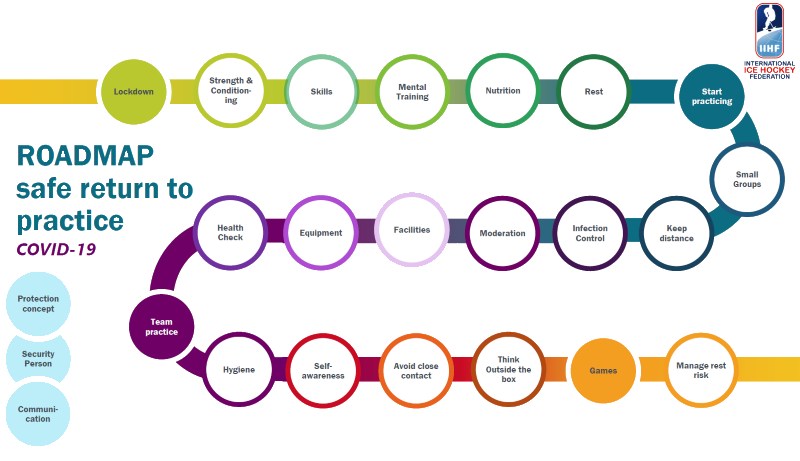In some countries ice rink have reopened for practices or even games.
photo: Andre Ringuette / HHOF-IIHF Images
The pandemic of the novel coronavirus (COVID-19) has ended the season in most of the IIHF’s member countries but hopefully sooner rather than later comes the time when teams can practise, play hockey and eventually have fans watch the players’ magic at the rink in a safe way. But that’s a future to be reached step by step and with discipline as the world battles against the spreading of the virus.
While the pandemic has uniquely affected every country resulting in each country being at a different stage of the pandemic, and while every country is working with its government, health and sports ministries on the issue, the IIHF Medical Committee has in the last few weeks produced guidance with a general roadmap and tools to support its member national associations, while also sharing examples from countries to learn from each other.
The roadmap consists of four phases:
The timing can be different depending on the countries. While some may still be in a full lockdown, others may already be back on the ice and playing games with possible restrictions for spectators.
Click on the image below to access the full roadmap with recommendations from the IIHF as well as resources from the WHO and the IIHF member national associations. This shall be used strictly in conjunction with the laws and recommendations from the authorities in your country and region.

While the pandemic has uniquely affected every country resulting in each country being at a different stage of the pandemic, and while every country is working with its government, health and sports ministries on the issue, the IIHF Medical Committee has in the last few weeks produced guidance with a general roadmap and tools to support its member national associations, while also sharing examples from countries to learn from each other.
The roadmap consists of four phases:
- Phase 1: Lockdown. No organized sport is possible, players can work out individually at home or outside on their strength and conditioning, skills, mental health, focus on nutrition and use the time to rest.
- Phase 2: Start practising. Some first organized trainings are possible in small groups according to the public health guidelines, optimize paths and the dressing room configuration, maintaining social distancing (minimum 2 metres) and showering at home, apply strict hand hygiene, disinfection of high-touch surfaces and equipment, practise infection control, avoid handshakes, limit access for spectators. Participants with risk factors are to be excluded, participants with signs of illness are strictly advised not to enter the premises and seek medical attention immediately.
- Phase 3: Team practice. Smaller groups than usual to ensure social distancing. Training is adjusted but similar to normal training. Better safe than sorry: if you don’t feel well, stay home and seek medical care. Avoid body contact and checks and practise social distancing on the ice in the choice of drills, by not using the player bench and minimizing chalk talk sessions. Consider wearing a full visor and create distance in the dressing room or use two dressing rooms.
- Phase 4: Games. Leagues continue, games take place. Follow the laws, recommendations and guidelines from the authorities in your country, region and community. Consider that in team sport the risk remains rather high, conduct a risk assessment i.e. with the WHO risk assessment tool for mass gatherings, prepare emergency action plans including isolation plans, use infection control thoroughly, use fist and elbow bumps instead of handshakes and for goal celebrations, consider games without spectators.
The timing can be different depending on the countries. While some may still be in a full lockdown, others may already be back on the ice and playing games with possible restrictions for spectators.
Click on the image below to access the full roadmap with recommendations from the IIHF as well as resources from the WHO and the IIHF member national associations. This shall be used strictly in conjunction with the laws and recommendations from the authorities in your country and region.
